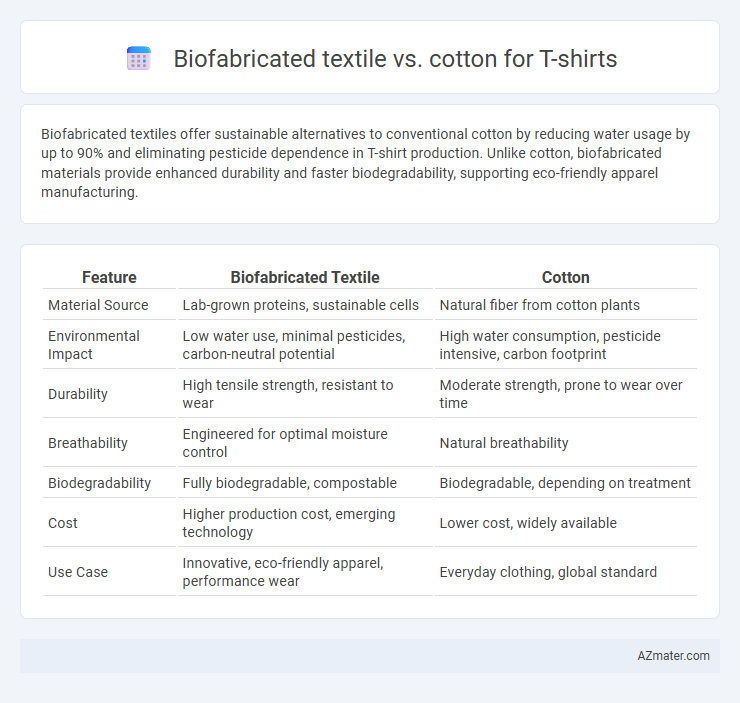Biofabricated textiles offer sustainable alternatives to conventional cotton by reducing water usage by up to 90% and eliminating pesticide dependence in T-shirt production. Unlike cotton, biofabricated materials provide enhanced durability and faster biodegradability, supporting eco-friendly apparel manufacturing.
Table of Comparison
| Feature | Biofabricated Textile | Cotton |
|---|---|---|
| Material Source | Lab-grown proteins, sustainable cells | Natural fiber from cotton plants |
| Environmental Impact | Low water use, minimal pesticides, carbon-neutral potential | High water consumption, pesticide intensive, carbon footprint |
| Durability | High tensile strength, resistant to wear | Moderate strength, prone to wear over time |
| Breathability | Engineered for optimal moisture control | Natural breathability |
| Biodegradability | Fully biodegradable, compostable | Biodegradable, depending on treatment |
| Cost | Higher production cost, emerging technology | Lower cost, widely available |
| Use Case | Innovative, eco-friendly apparel, performance wear | Everyday clothing, global standard |
Introduction to Biofabricated Textiles and Cotton
Biofabricated textiles are engineered materials created through biological processes, often using microorganisms or cultured cells to produce fibers that mimic natural fabrics. Cotton, a natural fiber harvested from the cotton plant, remains the most widely used and traditional material for T-shirts due to its softness, breathability, and widespread availability. Biofabricated textiles offer sustainable alternatives by reducing water usage and environmental impact compared to conventional cotton farming, which requires significant land, pesticides, and water resources.
Origins and Production Processes
Biofabricated textiles are produced using microbial fermentation and cell cultures that create natural fibers without traditional agriculture, significantly reducing water and land use. Cotton, originating from the Gossypium plant, relies on extensive farming practices involving soil cultivation, irrigation, and pesticide use, resulting in high environmental impacts. The production of biofabricated textiles emphasizes sustainable biotechnology and scalable labs, while cotton production depends on seasonal harvest cycles and mechanical processing of raw fibers.
Environmental Impact Comparison
Biofabricated textiles reduce environmental impact by using fewer natural resources and generating less waste compared to traditional cotton. Cotton cultivation consumes significant water--approximately 2,700 liters per kilogram--and involves pesticide use that harms ecosystems. Biofabricated textiles offer a sustainable alternative with lower carbon emissions and reduced water footprint, minimizing soil degradation and chemical runoff associated with cotton farming.
Material Properties and Performance
Biofabricated textiles offer superior moisture-wicking, breathability, and tensile strength compared to traditional cotton, enhancing comfort and durability in T-shirts. Cotton's natural softness and biodegradability remain advantageous but often lack the enhanced stretch and abrasion resistance seen in lab-grown fibers. Advances in biofabrication enable customizable fiber properties, allowing for improved thermal regulation and faster drying times, surpassing conventional cotton performance.
Comfort and Wearability
Biofabricated textiles offer superior moisture-wicking properties and enhanced breathability compared to traditional cotton, improving overall comfort during extended wear. These innovative fabrics are engineered for optimal stretch and flexibility, resulting in better fit and reduced fabric fatigue. Cotton, while naturally soft and highly breathable, tends to absorb moisture and can lose shape over time, impacting long-term wearability.
Design Versatility and Aesthetic Appeal
Biofabricated textiles offer greater design versatility compared to traditional cotton due to their customizable properties, allowing for innovative textures, colors, and patterns tailored to specific aesthetic preferences. Unlike cotton, which has limitations in fiber thickness and weave, biofabricated materials enable designers to experiment with structure and finish, resulting in unique visual and tactile experiences. This enhanced adaptability makes biofabricated textiles ideal for fashion-forward T-shirts that prioritize both style and sustainability.
Cost and Scalability
Biofabricated textiles offer promising scalability potential through controlled lab production, reducing dependency on agricultural inputs compared to conventional cotton, which requires extensive land, water, and labor. The cost of biofabricated T-shirts currently exceeds that of cotton due to nascent technology and production complexity, but advancements in biotechnology and economies of scale may lower expenses over time. Cotton remains cost-effective and widely available with established supply chains, though environmental concerns and resource-intensive cultivation challenge its long-term viability.
Consumer Acceptance and Market Trends
Biofabricated textiles are gaining traction in the T-shirt market due to their sustainability credentials, appealing to environmentally conscious consumers and aligning with rising demand for eco-friendly apparel. Cotton, a traditional textile, maintains strong consumer loyalty because of its comfort, breathability, and established production infrastructure. Market trends indicate a growing shift toward biofabricated fabrics supported by innovations in biotechnology and increasing investments, yet widespread adoption depends on overcoming cost and scalability challenges.
Sustainability and Ethical Considerations
Biofabricated textiles for T-shirts offer a sustainable alternative by significantly reducing water consumption and carbon emissions compared to conventional cotton farming, which typically requires substantial pesticide use and extensive land resources. Ethically, biofabrication promotes animal welfare through cruelty-free production methods and supports transparency in supply chains, contrasting with cotton's association with labor-intensive practices that often involve unfair wages and poor working conditions. Incorporating biofabricated materials advances circular fashion goals by enabling biodegradable and regenerative product lifecycles, positioning itself as a forward-thinking solution in the sustainable apparel industry.
Future Prospects for T-Shirt Manufacturing
Biofabricated textiles, made from lab-grown proteins and sustainable materials, offer a revolutionary alternative to traditional cotton in T-shirt manufacturing by reducing water consumption and eliminating pesticide use. These innovative fabrics can be engineered for enhanced durability, breathability, and biodegradability, positioning them as a key solution for eco-friendly and high-performance apparel. The future of T-shirt production lies in integrating biofabrication technologies to meet growing consumer demand for sustainable fashion and minimize environmental impact.

Infographic: Biofabricated textile vs Cotton for T-shirt
 azmater.com
azmater.com